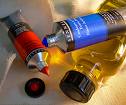How to save my oil colors go wasted?
By arvensis
@arvensis (85)
India
July 26, 2007 6:22am CST
I love painting and some days ago I recieved oil colors as gift but I don't understand how to use them,I have oil,brush,but I dont have proper canvas.I tried to paint on normal paper and the result was so bad,the oil came out of the color and destroyed the look of my creation,I tried it on normal thick cotton cloth but the result was same then somewhere i read that the artist used to apply some gum on the cloth before painting with the oil colors,I did so but still it was not satisfying, now I m going to buy a professional canvas but some of my friends say that even then I have to do something on that canvas first before painting and they dont know exactly what.If anyone knows how can I use these fascinating colors properly please do tell me!!
2 people like this
3 responses
@drannhh (15219)
• United States
30 Jul 07
First off, as expensive as good oil paints can be, in my view the first thing you need to know is how to protect your brushes. The solvent you want to use for thinning your paint and cleaning your brushes is an ODORLESS turpentine substitute such as Turpenoid, rather than turpentine itself. There are other brands than turpenoid which are less expensive and work just as well, but it is important to get the one that says it is odorless, NOT the one that calls itself "natural" which has a different consistency and is also very stinky. You don't want to ever mix water with your oil paints, but after cleaning the brushes first with turpenoid, then you want to clean them VERY well with soap and water. I find that the best soap for cleaning brushes is called Simple Green, a common household cleaning liquid, but really, you can use almost anything, even bar soap or Dawn dish detergent. Just be sure to clean the brush thoroughly (at least 3 more times after you think it is already clean!) and then rinse thoroughly and let the brushes dry completely before using them again.
Although it is possible to use oil paint right out of the tube, it is much better to have a little Turpenoid-like thinner out for mixing and to keep your brushes clean as you work. The muddy colors that are a sure indication of a novice painter come from letting the colors run together on your palette and from failing to clean the brush carefully between color changes. If you do not carefully clean your brushes after you finish painting, you will come back to a disgusting ruined brush, with broken hairs and gunk hardened in the ferrule, which will run down and ruin all of your paintings for the life of the brush.
As you found out, you cannot use oil paints satisfactorily on paper, but if you cannot afford to buy proper canvas--or if it is not available where you live, you can paint on smooth wood. In fact, the Mona Lisa was painted on an inexpensive wood panel instead of canvas. If Leonardo can do it, you can, too!
Back when I was a "starving" artist I used to go to thrift shops and buy awful paintings for pennies just to get the frames which I cleaned up to reuse. Then I sanded down the canvas from each bad paintings to make the surface clean, washed it, and painted gesso over it, which when dry made the canvas almost like new. If you cannot find Gesso, white acrylic paint also works. Gesso comes in a big jar and is much cheaper than your oil paint, so it is a good thing to use to cover any non-porous surface that you might want to use as a substitute for canvas. If I am just practicing or goofing around, I sometimes put Gesso over some cheap cardboard pulled out of the trash and paint on it. The problem with that is if your painting turns out really good, then you will be sorry you didn't put it on something nice. But I think even cardboard is OK when you are first learning how to use a brush.
When you dip your brush in the paint or in the thinner, be sure to just dip the tip! Most new painters have a tendency to load too much paint on the brush. Use a glass or ceramic dish and put just a little of each color out, keeping them separate and then recap the tubes before beginning so it doesn't dry out.
Another thing is that you can save and reuse your Turpenoid. Just put it in a glass jar with a tight cap. Mason-type canning jars work best, but any food jar that has a nice screw-on lid is fine. After a week or so, all the pigment will settle to the bottom and you can pour the clean turpenoid off the top. Over time, the turpenoid will start to discolor, but it will still be good with dark colors or for cleaning your brushes.
If you have any more questions about this subject don't hesitate to ask! Oil painting is a wonderful hobby that anyone can enjoy, but there are a few tricks that make your results more pleasing.
@naty1941 (2336)
• United States
30 Jul 07
If you are buying a professional canvas then make sure it has gesso on it. Otherwise, you have to gesso it first before painting on the canvas. You will need turpentine or some form of thinner for the paint if you want to use it liquidy. However, you can use the paint right out of the tube without thinning it. You have to let oil paint dry thoroughly before you varnish it. There are many books in the library that can assist you with oil painting. Good Luck.
2 people like this








